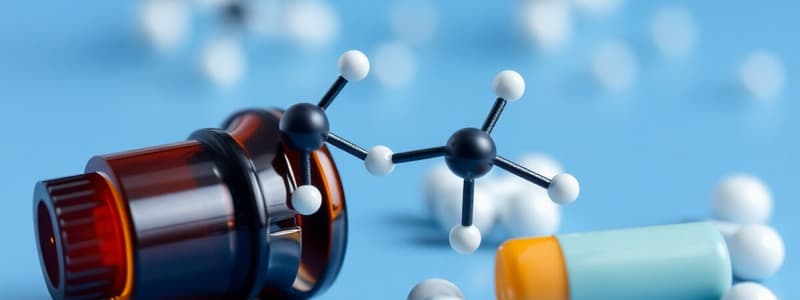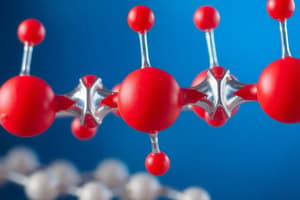Podcast
Questions and Answers
A patient presents with symptoms suggestive of myasthenia gravis. Considering diagnostic accuracy and speed of onset, which cholinesterase inhibitor would be MOST appropriate for an initial diagnostic test?
A patient presents with symptoms suggestive of myasthenia gravis. Considering diagnostic accuracy and speed of onset, which cholinesterase inhibitor would be MOST appropriate for an initial diagnostic test?
- Physostigmine, given its tertiary amine structure enabling CNS penetration, providing a comprehensive assessment of both peripheral and central effects.
- Pyridostigmine, because of its intermediate duration of action, allowing for sustained improvement in muscle strength, facilitating a more thorough diagnostic evaluation.
- Neostigmine, due to its quaternary ammonium structure limiting CNS penetration and reducing potential central side effects during diagnostic use.
- Edrophonium, because its rapid onset and short duration of action allows for quick assessment of muscle strength response and minimizes prolonged cholinergic side effects. (correct)
For a patient undergoing treatment with an organophosphate insecticide who presents with severe cholinergic crisis, why is the administration of pralidoxime within 12 hours considered critical, and what is the MOST accurate mechanism underlying this urgency?
For a patient undergoing treatment with an organophosphate insecticide who presents with severe cholinergic crisis, why is the administration of pralidoxime within 12 hours considered critical, and what is the MOST accurate mechanism underlying this urgency?
- Pralidoxime enhances the metabolism of accumulated acetylcholine in the synapse, reducing the intensity of muscarinic and nicotinic effects regardless of the duration of exposure.
- Pralidoxime reverses the irreversible binding of organophosphates to acetylcholinesterase by undergoing nucleophilic attack, regenerating active enzyme before 'aging' stabilizes the bond. (correct)
- Pralidoxime prevents the organophosphate from penetrating the central nervous system, thereby limiting the progression of central nervous system toxicity even after prolonged exposure.
- Pralidoxime competitively binds to muscarinic receptors, preventing further acetylcholine binding and subsequent overstimulation, independent of the aging process.
In cases of suspected mixed overdose involving both atropine and a short-acting cholinesterase inhibitor, what considerations should guide the selection and administration of physostigmine as an antidote, given its unique pharmacokinetic and pharmacodynamic properties?
In cases of suspected mixed overdose involving both atropine and a short-acting cholinesterase inhibitor, what considerations should guide the selection and administration of physostigmine as an antidote, given its unique pharmacokinetic and pharmacodynamic properties?
- Physostigmine should be avoided due to its potential to exacerbate central anticholinergic effects, thereby increasing the risk of seizures and cognitive impairment.
- Physostigmine should be cautiously administered, starting with low doses, to counteract both central and peripheral anticholinergic effects of atropine while carefully monitoring for cholinergic excess. (correct)
- Physostigmine is the preferred antidote in all cases, regardless of the mixed overdose scenario, due to its ability to rapidly reverse both atropine and cholinesterase inhibitor toxicities without significant adverse effects.
- Physostigmine is contraindicated due to its quaternary ammonium structure preventing CNS penetration, rendering it ineffective against central atropine toxicity and increasing peripheral cholinergic effects.
Considering the therapeutic management of Alzheimer's disease with cholinesterase inhibitors like donepezil, what is the MOST critical factor determining the long-term effectiveness of these drugs in slowing cognitive decline?
Considering the therapeutic management of Alzheimer's disease with cholinesterase inhibitors like donepezil, what is the MOST critical factor determining the long-term effectiveness of these drugs in slowing cognitive decline?
In the context of glaucoma management, how does physostigmine administration facilitate the reduction of intraocular pressure, and what are the precise mechanisms underlying its effects on aqueous humor dynamics?
In the context of glaucoma management, how does physostigmine administration facilitate the reduction of intraocular pressure, and what are the precise mechanisms underlying its effects on aqueous humor dynamics?
Flashcards
Cholinesterase (ChE)
Cholinesterase (ChE)
Enzymes that hydrolyze acetylcholine. Includes True ChE (in ganglia, NMJ, CNS) which specifically metabolizes Ach, and Pseudo ChE (in plasma & liver), which metabolizes Ach and other drugs.
Cholinesterase Inhibitors
Cholinesterase Inhibitors
Drugs that inhibit cholinesterase, leading to increased acetylcholine levels. Can be reversible (e.g., physostigmine, neostigmine) or irreversible (e.g., organophosphates).
Physostigmine
Physostigmine
Natural alkaloid that is well-absorbed from the GIT and can pass into the CNS; used for glaucoma and as an antidote to atropine poisoning.
Neostigmine
Neostigmine
Signup and view all the flashcards
Organophosphates
Organophosphates
Signup and view all the flashcards
Study Notes
Indirect Cholinergic Agonists
- Cause indirect stimulation of cholinergic receptors.
- Relevant topics include classification, mechanism of action, and uses.
- Can be used to treat organophosphorus poisoning.
Cholinesterase Activity
- True Cholinesterase is located in ganglia, neuromuscular junctions (NMJ), and the central nervous system (CNS).
- True Cholinesterase specifically metabolizes acetylcholine (Ach).
- Deficiency of True Cholinesterase is fatal, and it regenerates in 2-3 months.
- Pseudo Cholinesterase is located in plasma and the liver.
- Pseudo Cholinesterase non-specifically metabolizes Ach and multiple drugs like Succinylcholine.
- Deficiency of Pseudo Cholinesterase is not fatal, and it regenerates in 2-3 weeks.
Indirect-Acting Parasympathomimetic Drugs
- Indirect-acting parasympathomimetic drugs inhibit cholinesterase, leading to increased acetylcholine levels.
- Two types of indirect-acting parasympathomimetic drugs exist: reversible and irreversible.
- Reversible drugs include physostigmine, neostigmine, pyridostigmine, and donepezil.
- Irreversible drugs include organophosphate compounds.
Physostigmine
- Physostigmine is a natural plant alkaloid and a tertiary amine.
- It is well-absorbed from the gastrointestinal tract (GIT).
- It is capable of passing into the central nervous system (CNS).
- Glaucoma(eye drop) and atropine poisoning can be treated with it.
Neostigmine
- Neostigmine is a synthetic quaternary ammonium compound.
- It is poorly absorbed from the gastrointestinal tract (GIT).
- Not capable of passing into the central nervous system (CNS).
- Neostigmine works directly on Nm receptors at the neuromuscular junction (NMJ).
- Neostigmine can be used to treat myasthenia gravis, post-operative retention of urine, post-operative paralytic ileus, and D-tubocurarine poisoning.
Neostigmine Substitutes
- Pyridostigmine has a longer duration of action than neostigmine.
- Pyridostigmine is more selective on the neuromuscular junction (NMJ) than neostigmine.
- Pyridostigmine is used for the treatment of myasthenia gravis.
- Edrophonium has a very short acting duration of about 5 minutes.
- Edrophonium is more selective on the neuromuscular junction (NMJ) than neostigmine.
- This drug is utilized in the diagnosis of myasthenia gravis.
Central Cholinesterase Inhibitors
- Donepezil and Rivastigmine cross the blood-brain barrier.
- These drugs increase acetylcholine at central cholinergic synapses.
- Central Cholinesterase Inhibitors are used to treat Alzheimer's disease to improve cognitive functions.
Organophosphorus Compounds
- Echothiophate is an organophosphorus drug used as eye drops in glaucoma treatment.
- Parathion and malathion are organophosphorus insecticides.
- Sarin and soman are organophosphorus nerve gases.
- They are highly lipid-soluble and rapidly absorbed through all routes, including the skin.
- Rapid central nervous system (CNS) penetration occurs with organophosphorus compounds.
- These compounds cause irreversible inhibition of cholinesterase leading to increased endogenous acetylcholine (Ach) at synapses.
- This results in severe muscarinic and nicotinic symptoms.
- Aging of Cholinesterase enzyme leads to complete enzyme inhibition, with the bond getting stronger within 12 hours.
Manifestations of Organophosphate Poisoning
- Organophosphate poisoning causes diarrhea, urination, miosis, and bradycardia.
- Can also generate cause bronchospasm, lacrimation, salivation, and sweating.
- Excitation of the central nervous system(CNS), hallucinations, convulsions, coma, and skeletal muscle twitches.
- The primary cause of death in organophosphate poisoning is respiratory failure.
- This is due to blocked airway, paralyzed respiratory muscles, and inhibited respiratory center.
Treatment for Organophosphate Toxicity
- Ensure patient airway and provide artificial respiration.
- Perform a stomach wash and skin was.
- Administer intravenous normal saline to raise blood pressure (BP).
- Atropine antagonizes peripheral and central muscarinic manifestations.
- Administer high doses of Atropine.
- Pralidoxime serves as a cholinesterase re-activator and dephosphorylates the cholinesterase.
- Pralidoxime is only effective before aging of the enzyme, within 12 hours.
- Diazepam is given to control convulsions.
Studying That Suits You
Use AI to generate personalized quizzes and flashcards to suit your learning preferences.




